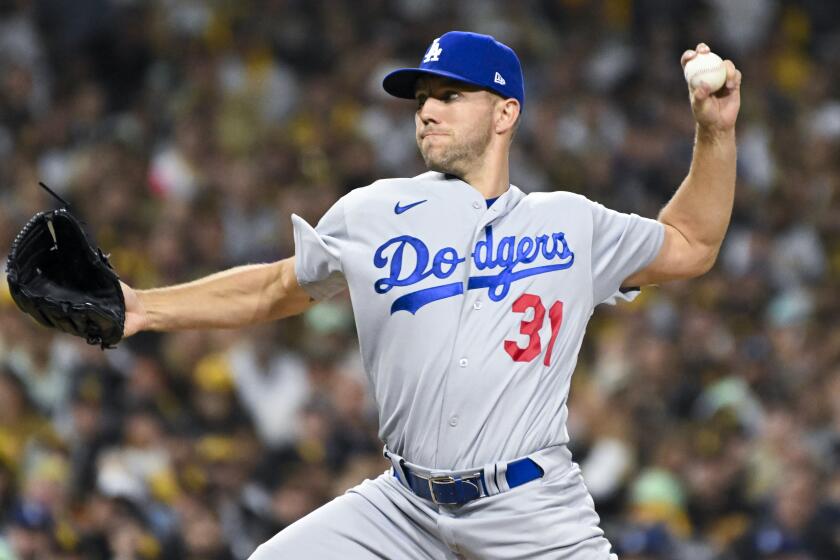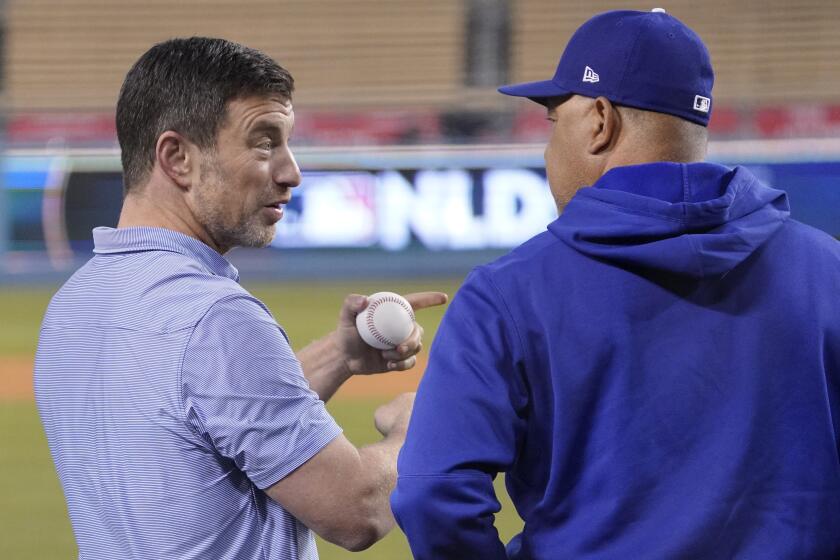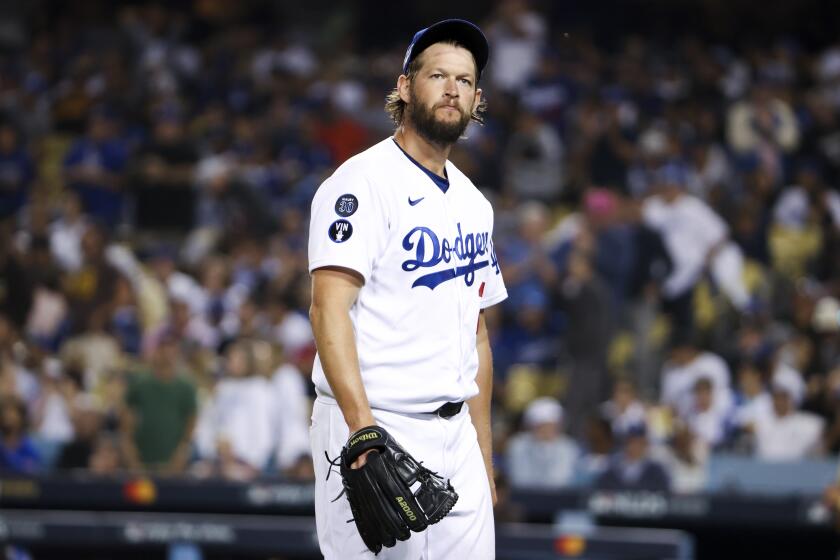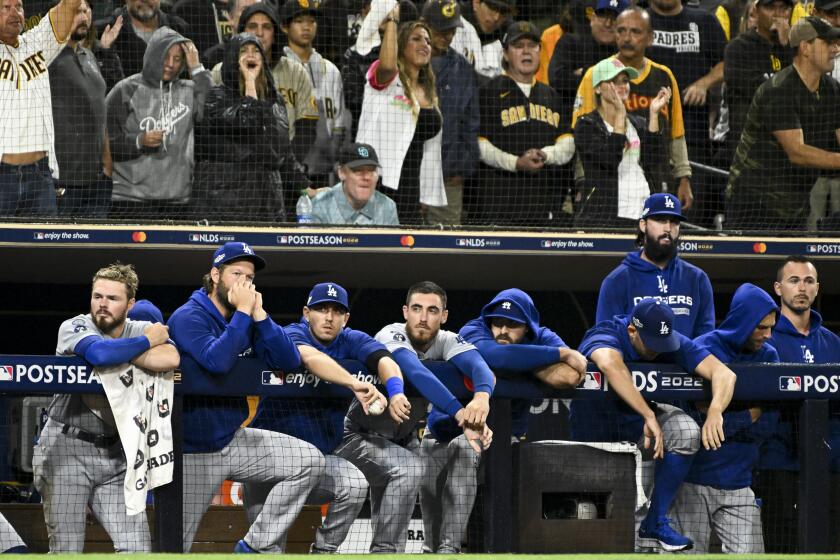Dave Roberts is expected back, but Dodgers face other key offseason questions
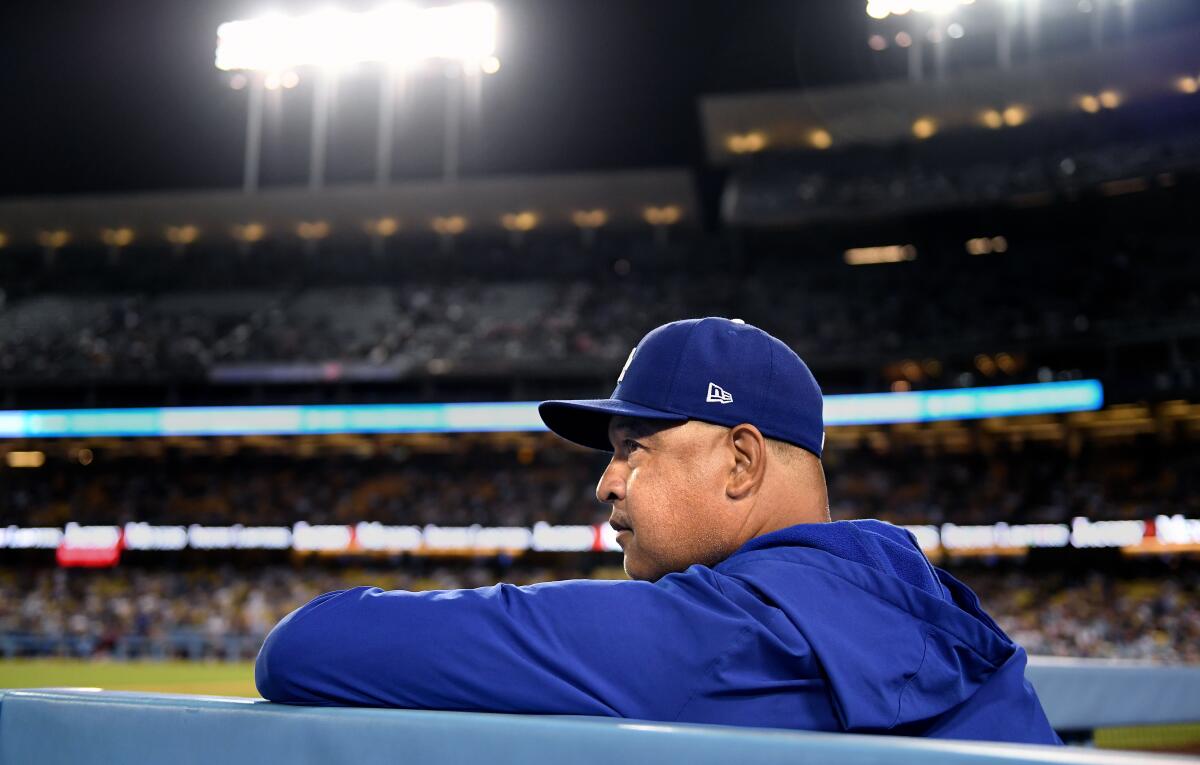
- Share via
After a decade of unprecedented regular-season dominance, but all too familiar playoff disappointment that continued Saturday night with their elimination in the National League Division Series, the Dodgers find themselves in a familiar place entering this offseason.
Trying to sustain the success that included winning a franchise-record 111 games this year — but build a team more consistent come October, where they’ve captured just one World Series championship during a stretch of 10 consecutive postseason appearances.
One thing that likely won’t change is the manager.
Dave Roberts, the target of fan frustration following the Dodgers’ failure to win more than one championship during his tenure, is expected to return in 2023 for his eighth season as the team’s manager, according to a person with knowledge of the situation who wasn’t authorized to speak publicly. Roberts is set to begin a three-year contract extension he signed before this season.
But after a disastrous NLDS defeat to the San Diego Padres this past week, which was sealed when the Dodgers blew a three-run lead in Game 4 on Saturday night, there are plenty of other unknowns the club will have to address.
Dodgers pitcher Tyler Anderson said he didn’t know before Game 4 of the NLDS he would be pulled from the game in the fifth inning.
Among them — the future of several players, including franchise icons Clayton Kershaw and Justin Turner.
“The goal is to win a championship,” Turner said in the aftermath of the Dodgers’ elimination Saturday. “To fall short of that in any round, it doesn’t matter, it’s not a good feeling.”
What made this failure particularly hard for the Dodgers to digest was that it came so quickly after a historic regular season.
Their 111 wins were tied for the fourth most in major league history. They led the majors in runs scored and fewest runs given up. They won their division by 22 games over the Padres. They were the heavy betting favorites to win their seventh World Series title in Los Angeles.
A couple of common themes emerged during the NLDS defeat.
Their potent offense slipped into a postseason drought, transforming from the highest-scoring unit in the major leagues during the regular season to an underwhelming, inefficient group that managed just seven runs in three consecutive losses after Game 1.
Dodgers manager Dave Roberts doesn’t deserve all the blame for the Dodgers’ season ending in grim fashion. Andrew Friedman also needs to be scrutinized.
Their pitching staff also failed to sustain its strong regular-season performance, too often faltering in key situations against a Padres team the Dodgers had beaten 14 times in 19 tries this year entering the series.
The Dodgers’ collapse in the seventh inning of Game 4 on Saturday encapsulated it all.
Their lineup managed just one run after having the bases loaded with no outs, missing an opportunity to further extend a three-run lead.
Their bullpen imploded against the Padres’ opportunistic offense, which scored five times in front of San Diego’s raucous home crowd.
And the Dodgers couldn’t recover the rest of the way, suffering one of the biggest upsets in baseball playoff history. They became the sport’s first team to win at least 110 games and fail to advance to a league championship series.

Said Kershaw, their likely future Hall-of-Fame pitcher: “It’s just another good regular season.”
Followed by another bout of playoff heartbreak.
So how do the Dodgers fix this? How do they reverse their postseason torment, with the 2020 World Series they won during a pandemic-shortened season still their only recent October reprieve?
That’s what the team’s front-office decision-makers, from president of baseball operations Andrew Friedman on down, will begin pondering in the coming days.
Roberts appears to be safe despite drawing criticism for several decisions during Saturday’s fateful seventh inning.
“We didn’t accomplish our goal, and that’s the bottom line,” Roberts said after the game. “Yeah, this one hurts.”
No manager in major league history has managed more games than Roberts with a better winning percentage than his .632 career mark. His 653 total wins are fifth most in franchise history.
He and the core of his current staff, including pitching coach Mark Prior and hitting coaches Brant Brown and Robert Van Scoyoc, helped navigate the team to its 2020 World Series title too.

However, they have now overseen early eliminations in the last two postseasons, with the latter involving a crucial lapse of communication during Saturday’s seventh-inning debacle.
In hopes of giving reliever Alex Vesia an extra moment to warm up, the Dodgers’ dugout signaled for pitcher Yency Almonte to lob a pickoff throw to first base. The sign was missed, however, with Almonte instead delivering a pitch to the plate, leading to the Dodgers making a risky mid-at-bat pitching change.
Moments later, the Padres took the lead with a hit.
“I don’t know how it got lost in translation,” Roberts said.
It wasn’t the team’s only problem last week.
Though Friedman has built a sustained regular-season winner with rosters built around big stars, homegrown talent and unheralded depth additions, his teams continue to show a tendency to press in October, especially at the plate.
Whether Clayton Kershaw will ever wear a Dodger uniform again is a big offseason question. As of now, the answer looks like yes.
“We did it to ourselves,” said Mookie Betts, the team’s $365-million right fielder who had only two hits in the series. “They did play well, but there were some situations where we didn’t execute.”
For all their composed veteran professionalism, the Dodgers also at times appear to lack the confidence and swagger of other title contenders — this year’s Padres team, which adopted the goose that landed in the outfield of Dodger Stadium during Game 2 as its unofficial series mascot, included.
“They had great at-bats the whole series and made big pitches when they had to, and they played better than us,” Kershaw said. “It’s hard to admit sometimes, but that’s the truth of it. They just beat us.”
And in the wake of this latest setback, the Dodgers face an offseason full of questions.
The club will have to make decisions on Turner, the third baseman who has a club option for $16 million entering his age-38 season; and former NL most valuable player Cody Bellinger, who despite struggling again this season, culminating in his benching for Games 3 and 4 of the NLDS, will likely get a raise on his $17-million salary in arbitration if the Dodgers tender the center fielder a contract.
Barely a week after setting a franchise record with 111 regular-season victories, the Dodgers see their season end in an NLDS loss to the Padres.
Shortstop Trea Turner headlines a collection of out-of-contract free agents, with pitchers Tyler Anderson, Andrew Heaney and Tommy Kahnle also bound to hit the open market without a new deal.
So too will Kershaw, though the 34-year-old left-hander will first have to decide whether he wants to continue his career.
“Yeah, I think so,” Kershaw said when asked whether he wants to play next season. “We’ll see what happens. Going home and being around and being a full-time dad changes your perspective on things. But as of right now, I’d say I’ll play again.”
If Kershaw stays with the Dodgers, he will be part of a club that should still be a contender in 2023.
The offense will still be headlined by former MVPs in Betts and first baseman Freddie Freeman. Cy Young Award candidate Julio Urías will be the ace of the pitching staff. And there’s little doubt in Friedman’s ability to build — and Roberts’ ability to manage — a winning team from April to September.
But for a franchise that now judges itself on October excellence, the Dodgers have to wait another 12 months to get their next title chance.
“It was super cool to win that many games [in the regular season],” Betts said. “But it means absolutely nothing if you lose in the postseason.”
More to Read
Are you a true-blue fan?
Get our Dodgers Dugout newsletter for insights, news and much more.
You may occasionally receive promotional content from the Los Angeles Times.

